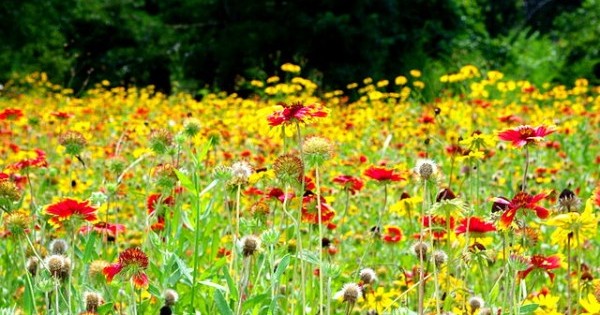
We’re in the midst of a worldwide mass extinction of living things, the fastest ever to occur in Earth’s 4.6 billion-year history, according to the American Museum of Natural History. Extinction is natural, but we’ve upped the rate by 1,000 times, according to biologist E. O. Wilson. And extinction is forever. You can’t bring back the dusky seaside sparrow, the Carolina parakeet, or the great auk. They are gone forever.
When I think of extinction, I tend to think tropical rain forest or tiger. But in North America, all sorts of regular birds, plants, butterflies and bugs, toads, frogs, and fish are under severe stress. As the book Bringing Nature Home by Douglas W. Tallamy points out, our natural areas are fragmented and shrinking. We have built four million miles of paved roads, and 43,480 square miles of blacktop and parking lot. “Alien grasses,” which inhabit the standard lawn, cover 40 million acres of North America. Since 1960 suburbia has increased in some parts of the United States by almost 6,000 percent. In Tallamy’s home state of Pennsylvania (46,058 square miles), he writes, less than one percent of the land can be considered “wild.”
This is discouraging news for the natural world that sustains us. But the good news is the point of Tallamy’s book: We can work enormous healing effects by a return, even if gradual, to native plants in our unwild gardens and yards.
I’m running late when it comes to getting on the bandwagon of native-plant gardening. A tree is a tree, right? A plant is a plant. A vine is a vine. Of course I knew about kudzu because—who doesn’t? But wasn’t that escaped ornamental that’s killing the forests of the South an egregious exception? (No, it isn’t.) And if you plant a nice “summer lilac” (Buddleia davidii) in the Pacific Northwest, as I have done, doesn’t that serve butterflies too? Isn’t that why it’s called the butterfly bush?
Native bugs evolved with native plants. “Native,” of course, depends on where you live. In Seattle trumpet honeysuckle is native. In New England, make that Virginia creeper or summer grape. As for “exotic”—meaning not native to a specific area, most bugs can’t use it for food. “Pest free!” the nurseries say. “Good!” you say. “Bugs away!”
But wait. Birds eat bugs. Birds also eat berries, and indeed, we plant berry-bearing bushes to attract birds. They eat berries, to be sure, but to feed their nestlings most birds need the protein that insects provide. And most native insects evolved in conjunction with native plants and can’t feed on most exotic plants. This explains why areas planted with exotics experience a decline in birds along with a decline in toads, frogs, spiders that eat insects, and insects that eat native plants—that is, most insects. Including most butterflies.
In natural woods, insects consume about 10 percent of the plants. Yet, as Tallamy notes, these woods are still beautiful. Nature in balance. Those who eat are in turn eaten.
My butterfly bush is native to China. Yes, butterflies are attracted to it. Very nice. But not a single species of native butterfly in North America can reproduce using the butterfly bush. Butterfly larvae need the native plant they evolved with to feed on. Hatched on an exotic plant, they starve. Too bad. The butterfly bush also attracts so many butterflies and other bugs that it’s displacing native nectar sources such as spreading dogbane (Apocynum androsaemifolium), which are under stress and pining for pollinators. My home is Seattle. In nearby Oregon my butterfly bush is displacing native willow trees. Here in Washington State, dense thickets of Buddleia davidii infest the shorelines of the Dungeness and Nisqually rivers, crowding out other plants and blocking human access to the shoreline. Indeed, I have planted, with loving care, a “Class B noxious weed,” according to the Washington State Noxious Weed Control Board. Good Lord.
The butterfly bush, like other escaped ornamentals, such as, in the Pacific Northwest, Scotch broom and English ivy, form monocrops that choke out native plants and the diverse ecosystems they support. An imported exotic can take a long time to “escape”—sometimes as long as 80 years. By then, it’s often too late. You can’t easily observe an escape. I see not one butterfly bush across my own street. But birds eat the seeds and poop them miles away.
All regions have analogous exotics. Most common, besides the Norway maple, the European native now pushing out native trees across America, is the neat expanse of the grass lawn. The lawn is an impoverished ecosystem. It’s a type of sterile garden that tends to become infested with an exotic bug, the Japanese beetle. The environment is not diverse enough to support the many eaters of Japanese beetles, so instead we bring out the insecticide. The same can be said of the azalea lace bug.
So, what to do? There’s no need to bulldoze our gardens. We can, at our own pace, edge toward less grass and more native plants. Aesthetics do matter. We do care about beauty. Besides, letting the yard run to weed will only convince the neighbors to keep on with the big lawn. Tallamy’s book is full of lists, suggestions, and illustrations, including the neatly edged grass path through native plantings. Information also abounds in native-plant societies and at native-plant nurseries.
We love our yards and gardens. We love our natural spaces. It’s good to know we can also garden to heal our damaged and stressed-out earth. I’ll begin by replacing that butterfly bush. I’ll put in creeping dogbane or an evergreen huckleberry, or maybe one of those gorgeous white-flowering mock oranges.

